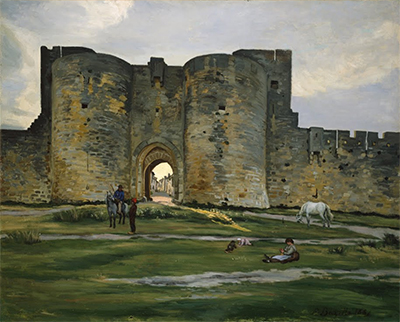Porte de la Reine at Aigues-Mortes, created in 1867, is an oil-on-canvas painting by Frederic Bazille that depicts a section of Medieval wall that encircles a French town.
The commune of Aigues-Mortes, situated in the Occitanie region of France, is around twelve miles from Bazille's hometown of Montpellier and the French painter decided to visit this historic location in order to create landscape paintings in the open air. Other paintings that were executed during this expedition focus more on the natural landscapes in the area while the painting of the Porte de la Reine, or Queen's Gate, places greater emphasis on the building than on the natural scenery. The painting, executed in the Impressionist style and measuring 80.6 cm by 99.7 cm, is on display at the Metropolitan Museum of Art in New York City.
The Queen's gate, which was in an excellent state of repair for a stone structure that had been built in the thirteenth-century, is the central focus of the painting and the town within can only be glimpsed through the arched entranceway. A handful of townsfolk, including a horseman talking to a pedestrian at the right-hand side of the canvas and a mother at the centre of the painting who is sitting on the grass while her two infant children crawl nearby, have gathered outside of the walls. Pathways, cut into the turf so that the pale earth is exposed, merge at the entranceway to form a road that is lined by houses on either side. A white pony, belonging to either the mother or the pedestrian, grazes beside the path on the right-hand side of the canvas.
Bazille, having taken up position near the Queen's Gate on a bright Spring day, creates the impression of individual stones with flecks of brown and grey paint that vary in shade as well as hue. Thin lines of white paint, tracing the smudges of brown and grey, represent the mortar that binds the stones together. Light cast by a southerly sun, blocked by the white houses in the street so that shadows are cast on the road, shines through the open arch in the gatehouse and illuminates a triangular portion of grass and pathway. The distant figures of three women, wearing ankle-length skirts, can be seen walking down the street together.




